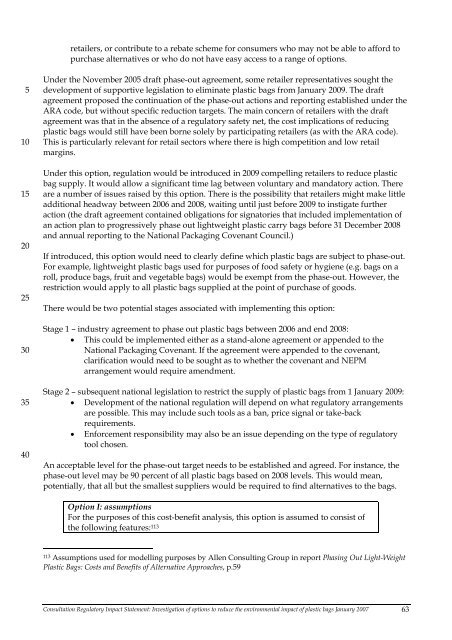Plastic Bags - COAG Standing Council on Environment and Water
Plastic Bags - COAG Standing Council on Environment and Water
Plastic Bags - COAG Standing Council on Environment and Water
You also want an ePaper? Increase the reach of your titles
YUMPU automatically turns print PDFs into web optimized ePapers that Google loves.
etailers, or c<strong>on</strong>tribute to a rebate scheme for c<strong>on</strong>sumers who may not be able to afford to<br />
purchase alternatives or who do not have easy access to a range of opti<strong>on</strong>s.<br />
5<br />
10<br />
15<br />
20<br />
25<br />
30<br />
35<br />
40<br />
Under the November 2005 draft phase-out agreement, some retailer representatives sought the<br />
development of supportive legislati<strong>on</strong> to eliminate plastic bags from January 2009. The draft<br />
agreement proposed the c<strong>on</strong>tinuati<strong>on</strong> of the phase-out acti<strong>on</strong>s <strong>and</strong> reporting established under the<br />
ARA code, but without specific reducti<strong>on</strong> targets. The main c<strong>on</strong>cern of retailers with the draft<br />
agreement was that in the absence of a regulatory safety net, the cost implicati<strong>on</strong>s of reducing<br />
plastic bags would still have been borne solely by participating retailers (as with the ARA code).<br />
This is particularly relevant for retail sectors where there is high competiti<strong>on</strong> <strong>and</strong> low retail<br />
margins.<br />
Under this opti<strong>on</strong>, regulati<strong>on</strong> would be introduced in 2009 compelling retailers to reduce plastic<br />
bag supply. It would allow a significant time lag between voluntary <strong>and</strong> m<strong>and</strong>atory acti<strong>on</strong>. There<br />
are a number of issues raised by this opti<strong>on</strong>. There is the possibility that retailers might make little<br />
additi<strong>on</strong>al headway between 2006 <strong>and</strong> 2008, waiting until just before 2009 to instigate further<br />
acti<strong>on</strong> (the draft agreement c<strong>on</strong>tained obligati<strong>on</strong>s for signatories that included implementati<strong>on</strong> of<br />
an acti<strong>on</strong> plan to progressively phase out lightweight plastic carry bags before 31 December 2008<br />
<strong>and</strong> annual reporting to the Nati<strong>on</strong>al Packaging Covenant <str<strong>on</strong>g>Council</str<strong>on</strong>g>.)<br />
If introduced, this opti<strong>on</strong> would need to clearly define which plastic bags are subject to phase-out.<br />
For example, lightweight plastic bags used for purposes of food safety or hygiene (e.g. bags <strong>on</strong> a<br />
roll, produce bags, fruit <strong>and</strong> vegetable bags) would be exempt from the phase-out. However, the<br />
restricti<strong>on</strong> would apply to all plastic bags supplied at the point of purchase of goods.<br />
There would be two potential stages associated with implementing this opti<strong>on</strong>:<br />
Stage 1 – industry agreement to phase out plastic bags between 2006 <strong>and</strong> end 2008:<br />
• This could be implemented either as a st<strong>and</strong>-al<strong>on</strong>e agreement or appended to the<br />
Nati<strong>on</strong>al Packaging Covenant. If the agreement were appended to the covenant,<br />
clarificati<strong>on</strong> would need to be sought as to whether the covenant <strong>and</strong> NEPM<br />
arrangement would require amendment.<br />
Stage 2 – subsequent nati<strong>on</strong>al legislati<strong>on</strong> to restrict the supply of plastic bags from 1 January 2009:<br />
• Development of the nati<strong>on</strong>al regulati<strong>on</strong> will depend <strong>on</strong> what regulatory arrangements<br />
are possible. This may include such tools as a ban, price signal or take-back<br />
requirements.<br />
• Enforcement resp<strong>on</strong>sibility may also be an issue depending <strong>on</strong> the type of regulatory<br />
tool chosen.<br />
An acceptable level for the phase-out target needs to be established <strong>and</strong> agreed. For instance, the<br />
phase-out level may be 90 percent of all plastic bags based <strong>on</strong> 2008 levels. This would mean,<br />
potentially, that all but the smallest suppliers would be required to find alternatives to the bags.<br />
Opti<strong>on</strong> I: assumpti<strong>on</strong>s<br />
For the purposes of this cost-benefit analysis, this opti<strong>on</strong> is assumed to c<strong>on</strong>sist of<br />
the following features: 113<br />
113 Assumpti<strong>on</strong>s used for modelling purposes by Allen C<strong>on</strong>sulting Group in report Phasing Out Light-Weight<br />
<str<strong>on</strong>g>Plastic</str<strong>on</strong>g> <str<strong>on</strong>g>Bags</str<strong>on</strong>g>: Costs <strong>and</strong> Benefits of Alternative Approaches, p.59<br />
C<strong>on</strong>sultati<strong>on</strong> Regulatory Impact Statement: Investigati<strong>on</strong> of opti<strong>on</strong>s to reduce the envir<strong>on</strong>mental impact of plastic bags January 2007 63
















